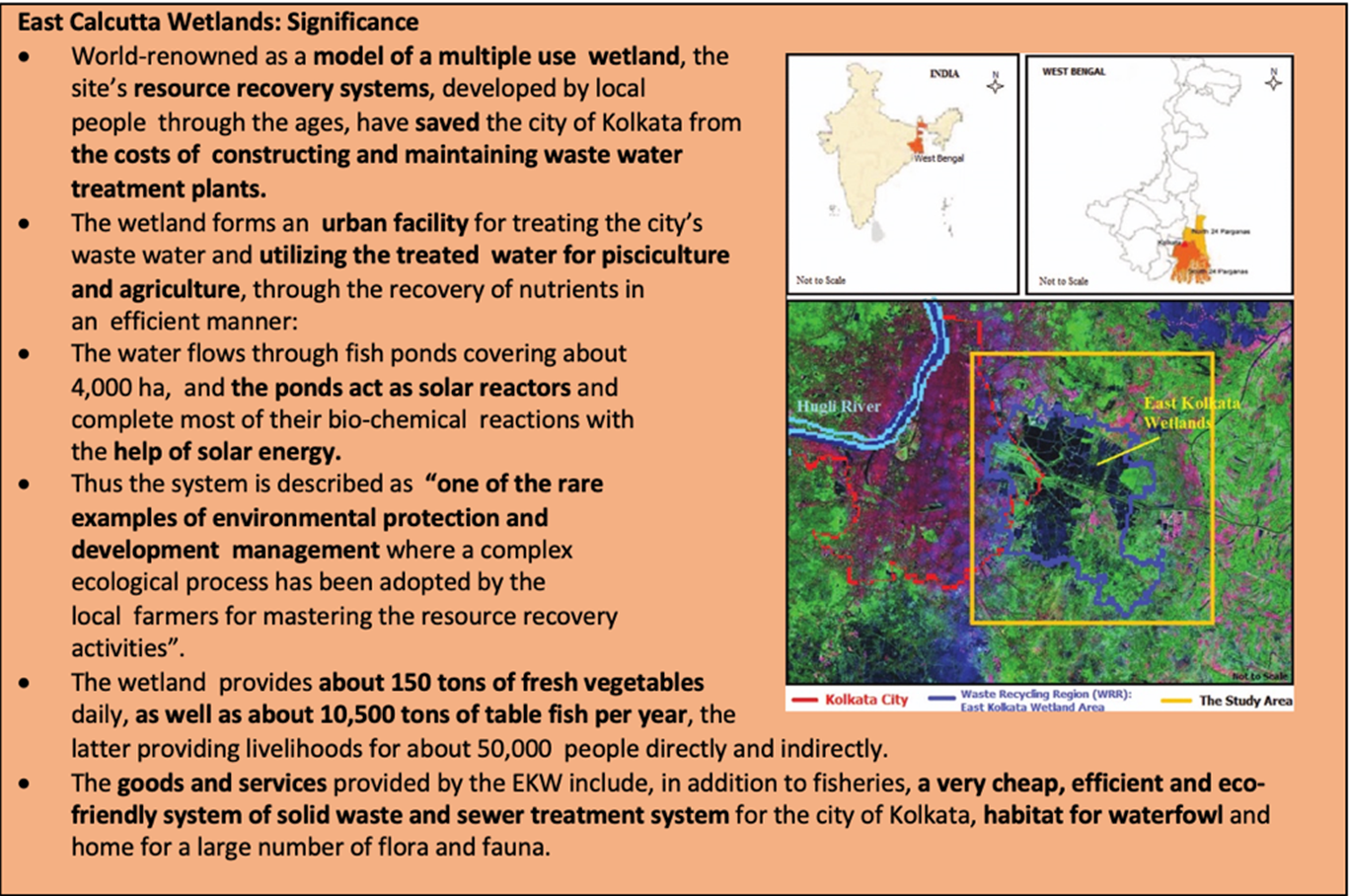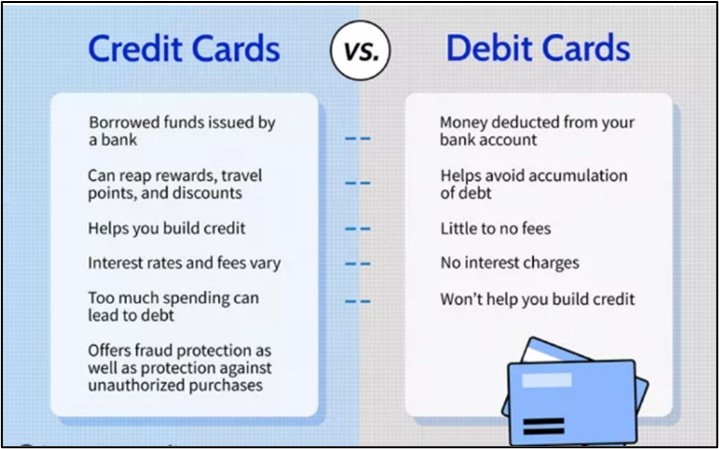Friday, 6th May 2022
WHO report on COVID-19 deaths
In News
The World Health Organisation (WHO) has recently released a report on deaths in India directly or indirectly due to COVID-19 during 2020 and 2021.
About the News
- According to a report, there were likely 4.7 million deaths in India which is highest, by far, for any country and comprise nearly a third of the 15 million such deaths globally.
- The figure is nearly 10 times that of the government’s official count as India officially estimated only 4.8 lakh cumulative deaths linked to COVID-19 as of December 2021.
- Minutes after the WHO released its estimate, India reiterated its “objection to the methodology” used by the organisation.
- The WHO’s estimates are however consistent with other research by scientists and media organizations which have put a midpoint estimate of 5.7 million deaths for India.
What are the important findings of the report?
- Highest toll
- Excess deaths: It refers to the difference between deaths registered in a given period and the deaths registered in a similar period in a normal year.
- Countries: With 1 million excess deaths, Russia is a distant second to India which has the highest toll.
- Population adjusted: When adjusted for population, deaths in India is not vastly different (1,710 excess deaths per million population) from high-income countries such as Poland and the US, despite their better healthcare systems. Peru had the worst death rate (4,370 excess deaths per million population).
- Gross undercount:
- Under-reporting: India’s excess deaths in the two years were at least 9 times the toll officially attributed to covid-19. Among countries with over 20,000 covid deaths, this was the worst scale of likely under-reporting after Egypt. Pakistan and Bangladesh fared better, with excess deaths that were 1.5 and 1.8 times their official covid death numbers.
- Mortality: World’s 20 countries (including India), which represent approximately half of the global population, account for over 80% of the estimated global excess mortality.
- Age and gender
- Age-group: The WHO estimates that the elderly was the most vulnerable group due to covid-19 with almost one in four excess deaths in India were in the 80-plus age group in 2020 and 2021. This accounted for 7% of the entire population in this age group.
- Gender-wise: In each age group, men were more vulnerable to death as there were 3 lakh deaths in males 60 and older in India in 2020 and 19 lakh deaths in that age group in 2021. On the other hand, there were 3.5 lakh deaths among women 60 and older in 2020 and 15 lakh deaths in 2021.
- Pattern: The likelihood of dying was higher across age groups in 2021, the year of the second wave in India, than in 2020. Globally, men accounted for 57% (8.5 million) of the excess deaths.

What are the major issues?
- Deliberate delays: Even before its release, the data from the UN health body has been under intense criticism from the Indian government, which reportedly tried to delay its publication.
- Biased methodology: India has questioned the WHO’s methodology, and strongly objected to the release as WHO “chose to ignore" the available data submitted by India and did not address the country’s concerns.
- Selective parameters: India’s prime objections were that the WHO used mathematical modelling to estimate deaths for India using parameters from reports such as the Global Health Estimates, test positivity data, that didn’t accurately reflect the Indian situation and ignored official death estimates.
Sources:
J&K Delimitation
In News
The Jammu and Kashmir Delimitation Commission recently notified the new boundaries, names and number of Assembly constituencies in Jammu and Kashmir, paving the way for the first-ever Assembly elections in the Union Territory that was carved out of the erstwhile State of J&K in 2019.
Important recommendations
- The Delimitation Commission recommended seven additional constituencies — six for Jammu and one for Kashmir — taking the total number of seats in the UT to 90 from 83 earlier.
- This will increase the number of seats in the Jammu Division to 43 from 37 seats earlier, and that in the Kashmir Valley to 47 from 46 earlier.
- The order also mentions reorganisation of the Parliamentary constituencies such that the five Lok Sabha seats now are made up of exactly 18 Assembly constituencies each, taking the total number to 90.
- Nine Assembly seats are to be reserved for Scheduled Tribes – six in Jammu and three in Kashmir.
- Regional distinction between Jammu and Kashmir is proposed to be removed and they are to be treated as one, as is reflected in the combining of Anantnag region in Kashmir with Rajouri and Poonch in Jammu to carve out Anantnag-Rajouri as a Parliamentary constituency.
- The panel also recommended that the Legislative Assembly of the Union Territory have at least two members – one of them a woman – from the Kashmiri migrant community with the right to vote at par with nominated members like in the Puducherry Assembly.
- Besides, it also recommended some representation to Persons displaced from Pakistan-occupied Jammu and Kashmir, and Kashmiri Pandits.
Necessity of the reorganization
- Delimitation became necessary when the Jammu and Kashmir Reorganisation Act, 2019 increased the number of seats in the Assembly.
- The erstwhile J&K state had 111 seats — 46 in Kashmir, 37 in Jammu, and four in Ladakh — plus 24 seats reserved for Pakistan-occupied Kashmir.
- When Ladakh was carved out as a Union Territory, J&K was left with 107 seats, including the 24 for PoK. The Reorganisation Act increased the seats to 114 — 90 for Jammu & Kashmir, besides the 24 reserved for PoK.
- After abrogation of J&K’s special status in 2019, the delimitation of both Assembly and parliamentary seats is governed by the Constitution.
- Earlier it was governed by the Jammu and Kashmir Representation of the People Act, 1957.
- The Delimitation Commission was set up on March 6, 2020. Headed by retired Supreme Court Justice Ranjana Prakash Desai, it has the Chief Election Commissioner and J&K’s Chief Electoral Officer as members, and J&K’s five MPs as associate members.
Controversy surrounding the exercise:
- The last delimitation exercise in J&K was carried out in 1995. In 2002, the then J&K government amended the J&K Representation of the People Act to freeze the delimitation exercise until 2026, as in the rest of the country.
- This was challenged in the J&K High Court and then the Supreme Court, both of which upheld the freeze.
- Again, political parties in Jammu and Kashmir have been pointing out that the Delimitation Commission is mandated by the Reorganisation Act, which is sub judice.
- Also, while delimitation as a rule is carried out on the basis of Census population, the Commission said it would take certain other factors into consideration for J&K, including size, remoteness and closeness to the border.
Sources:
Vibrant Village Programme
In News
The Union Minister of State, Ministry of Home Affairs has recently assured that the migration of people from border areas, in search of more facilities, will be minimised in the next two years, with effective implementation of the Centre’s new Vibrant Village Programme (VVP).
About the News
- Through the VVP, the Centre, is planning to rehabilitate people living along the international borders by providing them with all basic facilities.
- Alongside, it aims to open the villages along the Chinese border for tourism.
Understanding Vibrant Village Programme
- What is it? The programme was announced in the Union Budget 2022-23 to enhance infrastructure in Border villages.
- It will cover villages along India's border with China, with sparse population specially in states like Himachal Pradesh, Uttarakhand, and Arunachal Pradesh that are usually left out.
- Nodal Ministry: This is an initiative of the Ministry of Rural Development.
- Objective: The activities under the programme will include construction of village infrastructure, housing, tourist centres, road connectivity, provisioning of decentralized renewable energy, direct to home access for Doordarshan and educational channels, and support for livelihood generation.
- Funds: The Border Management fund allotted to the Ministry of Home Affairs has seen a jump of more than 42% compared to the previous year. However, additional funding for these activities will be provided.
- Regular Monitoring: Existing schemes will be converged and their outcomes will be defined and monitored on a constant basis under the programme.
Significance of the Programme
- It ensures national security and prevents migration from border villages as they are the asset to the nation.
- The border villages of the country are characterised by difficult terrain, weak transport networks and suboptimal socioeconomic indicators.
- Such villages have sparse population, limited connectivity and infrastructure and are often left out from the development gains.
- These regions lack development benefits that other states enjoy.
- It emphasizes on all efforts to improve social and economic infrastructure to ensure that these people continue to live in border villages.
- Through this programme, the government accords utmost priority to social and economic wellbeing of border population and to provide them all facilities like connectivity, safe drinking water, schools, hospitals and other facilities to ensure sustainable living in these areas.
Source:
- Centre’s new scheme to minimize of people from border areas: Union Minister
- Vibrant Village Programme
- Vibrant Village Programme announced in Budget important for development of border villages: PM Modi
Image source:
Motilal Nehru
On May 6, 1861 Motilal Nehru was born in Allahabad. Motilal Nehru, in full Pandit Motilal Nehru, was a leader of the Indian independence movement, co-founder of the Swaraj (“Self-rule”) Party, and the father of India’s first prime minister, Jawaharlal Nehru. Motilal, a member of a prosperous Brahman family of Kashmiri origin, early established a lucrative law practice and was admitted to the Allahabad High Court in 1896. He shunned politics until middle age, when, in 1907, at Allahabad, he presided over a provincial conference of the Indian National Congress (Congress Party). He was considered a moderate (one who advocated constitutional reform, in contrast to the extremists, who employed agitational methods) until 1919, when he made his newly radicalized views known by means of a daily newspaper he founded, The Independent. In 1928 he wrote the Congress Party’s Nehru Report, a future constitution for independent India based on the granting of dominion status.
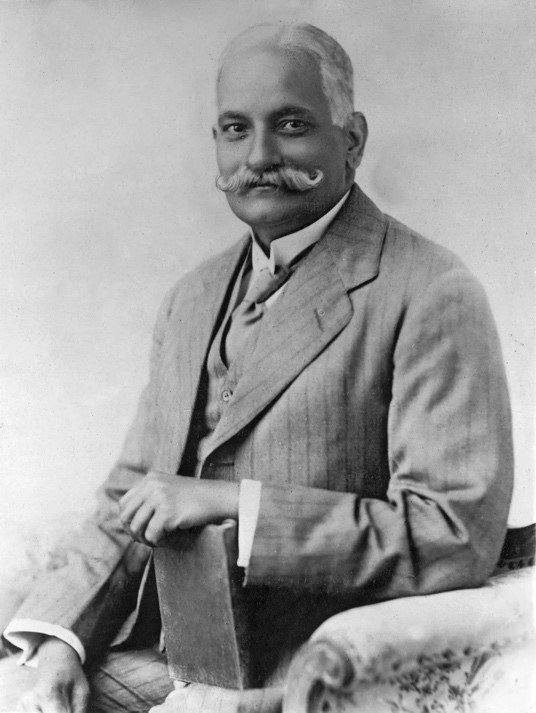
Source:
RBI Report- Currency and Finance 2021-22
In News
According to Reserve Bank of India’s (RBI) Report on Currency and Finance (RCF), Indian economy may take another 13 years to overcome the losses caused by the outbreak of COVID-19 pandemic.
About the Report
- The theme of the Report is “Revive and Reconstruct” in the context of nurturing a durable recovery post-COVID and raising trend growth in the medium-term.
- The report reflects the views of the contributors and not of the Reserve Bank.
- The Report focuses on the Economic distress caused due to pandemic, issues in the economy and the effect of pandemic on them and lists down various measures that need to be taken to address the problems.
Scars of the Pandemic
- The cyclical slowdown that set in the Indian economy before the outbreak of the pandemic, got exacerbated by the pandemic.
- The pandemic has caused a deep dent on livelihoods and has scarred minds, production capacities and confidence with far-reaching economic and social costs.
- The output loss for individual years have been worked out at ₹19.1 lakh crore, ₹17.1 lakh crore and ₹16.4 lakh crore for 2020-21, 2021-22 and 2022-23, respectively
- Despite the second wave, the turnaround in the economy in 2021-22 has been remarkable with all the components of aggregate demand surpassing the pre-pandemic levels in Q2:2021- 22.
- Taking actual growth rate of (-) 6.6% for 2020-21, 8.9% for 2021-22 and assuming growth rate of 7.2% for 2022-23 and 7.5% beyond that, India is expected to overcome COVID-19 losses in 2034-35.
- India’s recovery from the pandemic, despite its innate strength of macroeconomic fundamentals, remains fragile and is yet to become broad-based.
- Global economic pressures have been on the rise due to supply disruptions in global value chains, commodity price rise caused by the Russia-Ukraine war and sanctions on Russia.
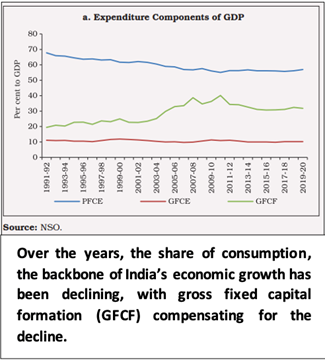
Rebalancing Monetary and Fiscal Policies Post-Pandemic
- The thrust of public policy action is now progressively shifting to revitalising growth – even as the fiscal policy stance aims at regenerating the capex cycle, monetary policy remains accommodative while focussing on the withdrawal of accommodation to ensure that inflation remains within the target going forward, while supporting growth.
- Large surplus liquidity that helped financial conditions to ease significantly during COVID needs to be withdrawn in a calibrated manner to ease out inflation.
- The report suggests that even under best possible macroeconomic outcomes, general government debt may not decline to below 75 per cent of GDP over the next five years.
- Fiscal consolidation is unlikely to be growth retarding, as the time varying fiscal multipliers for India suggest. Once the economy returns to steady state, fiscal multipliers can change from greater than one during a crisis to less than one or even negative.
- The fiscal multiplier measures the effect that increases in fiscal spending will have on a nation's economic output, or gross domestic product (GDP).
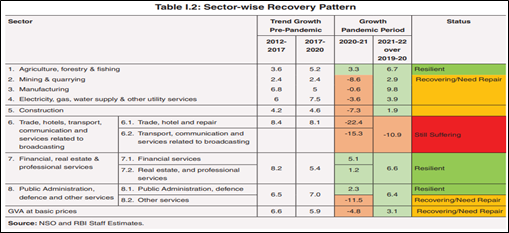
Structural Issues in Rejuvenating Growth
- The Indian economy was riddled with several structural impediments to growth even before the outbreak of COVID-19 which had dampened the investment outlook. Structural Issues in Agriculture, Manufacturing and Service Sector need to be addressed for the revival and reconstruction of Indian economy.
- Recognising the need for urgent and bold structural reforms, the Government has announced privatisation and asset monetisation; tax reforms (GST and corporate tax rationalisation); targeted sector-specific incentives to raise production and exports under the production linked incentive (PLI) scheme; insolvency and bankruptcy code (IBC) to improve the credit culture and resource allocation mechanism; labour reforms (four codes); and a fiscal policy focus on capex and infrastructure.
- While aiming to boost India’s participation in global value chains (GVCs) and raise export competitiveness, greater adoption of technology assumes critical importance.
- The reform package of the future hinges around (i) an ecosystem that increases the adaptability of domestic firms to state-of-the-art technology; (ii) ensuring policy certainty on royalty payments for technology transfer by foreign companies; (iii) improving domestic R&D infrastructure for innovations.

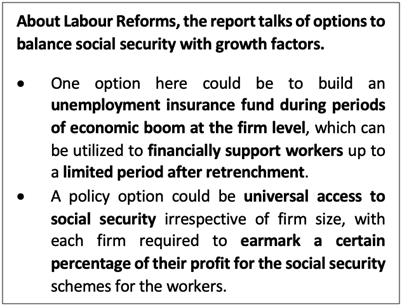
Exports and role of Finance in the Economy
- Growing incidents of geo-political conflicts can have economic repercussions by strengthening the case for a reconfiguration of global supply chains. India’s foreign trade policy, therefore, needs to recognise the opportunities that may come along with the evolving world economic order.
- The growing focus on digitalisation offers immense opportunities.
- India’s ongoing and future FTA negotiations must focus not only on securing greater market access for domestic goods and services but also on better trade terms for high quality imports from partner countries and transfer of technology.
- Industrial revolution 4.0 and committed transition to a net-zero emission target warrant a policy ecosystem that facilitates provision of adequate access to risk capital and a globally competitive environment for doing business.
- Going forward, the economy’s growing reliance on the digital ecosystem will be helpful in harnessing the benefits of low-cost resource allocation and distributive efficiency.
Conclusion:
As per the report, the already sluggish growth of economy was hit badly by the pandemic. There are structural issues that need to be addressed to further growth in the post-pandemic period. Moreover, the changing global scenario makes it important for India to focus on exports and the global value chain. Simultaneously a push towards digitization will help with the growth.
Question: Government and RBI have taken several steps to revive the economy from the Economic impacts of the Pandemic. Elaborate
Sources:
- India to overcome Covid-19 pandemic losses by FY35, says RBI report
- Economy to take till 2035 to overcome Covid losses: RBI
- Indian economy may take till 2034-35 to overcome COVID-19 losses: RBI
- Report on Currency and Finance (RCF) for the year 2021-22
- Economy may take more than a decade to overcome COVID-19 losses: RBI report
- Report on Currency and Finance
- May take India more than a decade to 'overcome losses' caused by Covid: RBI Report
Fireflies
This is image of synchronous display of light by several lakhs of fireflies near Top Slip in the Anamalai Tiger Reserve (ATR), Tamil Nadu, recently. The insects emitted light synchronously, starting from one tree, and the relay was carried across the Anamalai Tiger Reserve forests. The cyclic phenomenon continued throughout the night for a few days. Researchers have observed that males emit light together in trees to attract females. There are around 2,000 species of fireflies, and there can be differences in the lighting pattern. Fireflies spend most of their lives as larvae - about a year or more living in soil and feeding on soft-bodied insects. The adults, as beetles, live for two to four weeks, and feed on nectar and pollen. The mass congregation of fireflies in ATR could be an indicator of a pristine ecosystem. Lack of lights, night tourism, habitation and vehicle movement could be reasons for the large population of fireflies in ATR.
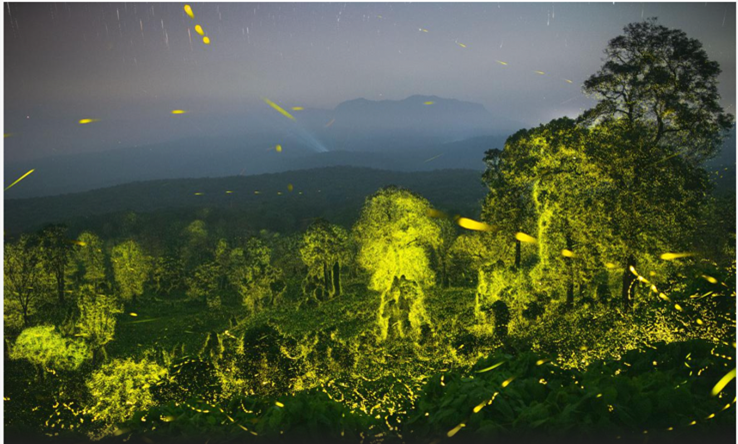
Source:
Mission to Venus: India
- Context: ISRO is planning a mission to Venus by 2024.
- The main purpose of the mission is to study what lies below the surface of the solar system's hottest planet, and to also unravel the mysteries under the Sulfuric Acid clouds enveloping it.
- The space agency is eyeing the December 2024 window for its launch. Orbital maneuvers have been planned for the following year when earth and Venus would be so aligned that the spacecraft could be put in the neighbouring planet's orbit using a minimum amount of propellant.
- The next similar window would be available in 2031.
- A key instrument on the spacecraft will be the high-resolution synthetic aperture radar to examine the Venusian surface, as it is covered by dense clouds that make it impossible to view the planet's surface
- The experiments planned in the mission include:
- An investigation of the surface processes and shallow sub-surface stratigraphy including active volcanic hotspots and lava flows.
- Studying the structure, composition, and dynamics of the atmosphere, and
- Investigation of solar wind interaction with the Venusian Ionosphere.

Source:
- ISRO plans mission to Venus, eyes Dec 2024 launch window
- Shukrayaan-I: ISRO planning mission to Venus, eyeing December 2024 launch window
Image source:
Mizoram: Second literate State
- Context: With the second highest literacy levels in the country, Mizoram has now become a modern state ready to take off for higher achievements.
- The literacy rate of Mizoram stands at 33%.
- The highest literacy rate was achieved by the central Mizoram's Serchhip district at 97.91% followed by Aizawl district at 97.89%
- The high literacy rate is the result of following efforts in state of Mizoram:
- There are about 2,000 schools in the state, a school to every 100 Mizo children.
- There's a village education committee in every village.
- Under the state's "each one teach one scheme ", there's a reward of Rs 100 to anyone who is successful in teaching an illiterate person to read and write.
- In 2020, the state government launched ‘Total Literacy Drive’ targeting areas with low literacy rates, as well as the ‘Special Eradication of Illiteracy Project’ under the flagship programme Socio-Economic Development Policy (SEDP) to achieve topmost literacy rate in the country.
- According to progress on Goal - 4 of UN Sustainable Development Goals which pertains to providing Quality Education, NITI Aayog’s SDG India Index 2020-21 shows that Mizoram with a score of 60 performed better than the national average of 57

Source:
- With the Second Highest Literacy Levels in The Country, Mizoram is a Truly Modern State Ready to Take Off for Higher Achievements
- Mizoram produces largest number of literates in India, but most suffer for want of jobs
- Mizoram ranks third in literacy rate in India
Image source:
Programme Mukti-Matrika
- Context: The Ministry of culture has recently organised Mukti-matrika program at Kolkata.
- The Mukti-matrika (‘Freedom as Mother’), encompasses the idea of ‘Mukti’ or freedom / independence/liberation, as well as the idea of ‘matrika’, an icon in which a land or a nation can be imagined.
- Binding these two themes, Mukti-Matrikawill establish the connection between Independence and Mother (Goodess Durga) with the view that Goddess Durga also symbolizes ‘Azadi’ - the deliverance from the clutches of evil, symbolized by the demon.
- The cultural programme is being organised in the backdrop of UNESCO inscription of the Durga Puja of Bengal in the list of the Intangible Cultural Heritage of Humanity.
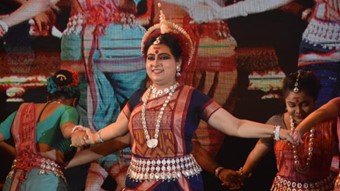
Sources:
- Shri Amit Shah, Minister of Home Affairs to attend the cultural programme Mukti-Matrika (‘Freedom as Mother’) at Victoria Memorial Hall, Kolkata tomorrow
- Sourav Ganguli’s wife Dona to perform at Centre's cultural event in Kolkata
Image source:
Mission Organic Value Chain
- Context: Manipur Chief Minister has launched the Direct Benefit Transfer for 18,000 registered farmers under Horticulture Department for Mission Organic Value Chain Development for North-eastern Region.
- Mission Organic Value Chain Development for North East Region (MOVCD-NER) is a Central Sector Scheme, launched by the Ministry of Agriculture and Farmers Welfare.
- It is a sub-mission under National Mission for Sustainable Agriculture (NMSA), and will be implemented in the states of Arunachal Pradesh, Assam, Manipur, Meghalaya, Mizoram, Nagaland, Sikkim and Tripura, during the 12th plan period.
- It aims to develop certified organic production in a value chain mode to link the farmer with the consumer.
- The initiative supports the development of the entire process-starting from inputs, seeds, certification, to the centre of facilities for collection, segregation, processing, marketing and branding.
- The initiative will empower 30-50 thousand farmers of north-eastern region through the creation of about 100 farmer producer companies and equip such companies with full value chain under its ownership and make North-eastern states the major suppliers of organic commodities for national and international markets.

Source:
- “Mission Organic Value Chain Development for North Eastern Region” (MOVCDNER)
- Other details
- Mission goals
Image source:
Let’s make GST a good and simple tax: Indian Express
Essence: The editorial speaks of indirect tax reforms that have been incorporated in India and those which are due. Globally, the introduction of value added tax (VAT) has added to reduction in cascading tax and increase in tax base and collection. India initiated the system of Goods and Services Tax (GST) to further this project. By reducing 11 such taxes by various authorities, the system of taxation has been harmonized. Collection exceeding 1.68 Lakh Cr in April 2022 has been possible due to increase in economic activity and stable technology platform (mandatory issue of e-invoice for business above Rs 100 Cr).
But one shortcoming of having multiple tax rates does exist. The arguments given in favor of the policy are- support to the poorer population who are the target beneficiary in the form of lower tax. But the issue related are inverted duty structure (e.g. railway wagons, some textile products, plastic bags, and solar modules). Multiple rates lead to litigations and misclassifications as well. Targeting a beneficiary could be done through providing cash transfers, improving quality of education and health. Having Few tax rates would help in reduction of lobby groups.
Presently, India has 4 rates of taxation apart from 0%, i.e. 5, 12, 18 and 28 percent. The idea is to reduce the tax to a single rate in the mid run but must be reduced to 3 rates sooner than later. Have 8, 15 and 40% of tax rates would be justified to simplify the GST.
Why should you read this article?
- To know the advantages of GST.
- To know the issues associated with multiple tax rates.
Source:
India must seize the trade opportunity: Indian Express
Essence: The editorial provides an insight into India’s export possibilities and challenges during times of pandemic and war. India has seen record $400 Bn and $250 Bn exports of merchandise and services. Though the global trade as a percentage of the global GDP grew for the whole world during pandemic times, there might be a slowdown in such transactions in the future. Reasons attributed are adverse geo-political environment, recurring waves of pandemic and prolonged supply chain hurdles.
India needs to be proactive during times of such uncertainty and tap the potential products and markets for exports. E.g. Sri Lanka and Ukraine are major suppliers of agricultural exports, providing tea and wheat/mineral oil to the world. As many as 25 African countries seek wheat imports from Europe. India, which is the 2nd largest producer of tea and wheat could participate in such high demand products. Sri Lanka’s textile market is seeking an upgrade due to power cuts and manufacturers are looking for an alternate production center. During the times of covid lock down in China and limited capacity in Vietnam, Cambodia and Bangladesh, India becomes the natural scalable supplier.
India needs to work to reduce the non-tariff barriers, support autonomous trade organizations away from bureaucracy, integrate itself with global supply chains with trade pacts, decrease tariff on intermediate goods, enable labor intensive processes, and have an FDI inflow policy. There is also a need to work on logistical and power cost and availability for India to become a part of global value chain.
Why should you read this article?
- To know the bottlenecks around the world which India could play on.
- To know the tasks that need to be accomplished to increase exports.
Source:
The school dress is in the cross hairs: The Hindu
Essence: As per the author, there is no evidence to say that a school uniform is a factor in learning and it only helps in the regimentation of the young. The origin of the school dress lies in the colonial system of education which favour strict enforcement of the school uniform and continued even after independence.
As per the author, the school uniform has currently mutated into a new political tool, and a means of curtailing the already limited autonomy of principals and teachers. Kothari Commission recommendation of 10+2 model was not implemented in some states which still have pre-university or junior colleges and its full potential has not been realised as school principals and teachers are not given greater say and freedom in establishing the norms that govern institutional life.
As per the author, a dress code expects children and their parents to avoid using clothes flaunting status or wealth. A uniform, on the other hand, goes as far as prescribing not just the colour but also the material and the design. The authors views that nowadays even a fully defined uniform does not seem to suffice s in Karnataka a student was stopped from entering the examination hall on account of a dress item.
Why should you read this article?
- To know about the authors views on the utility of school dress and its origin.
- To understand the drawbacks of non-implementation of the Kothari Commission recommendation.
- To understand the key difference between uniform and dress code.
Source:
Lost Heer Project
Background
- The partition of India in 1947 and the ensuing mass exodus resulted in a genocide that no one could have predicted.
- 'The Lost Heer Project,' a 2018 Instagram collective, is currently striving to rediscover the origins of an era and the stories of its strong women that appear to be long forgotten.
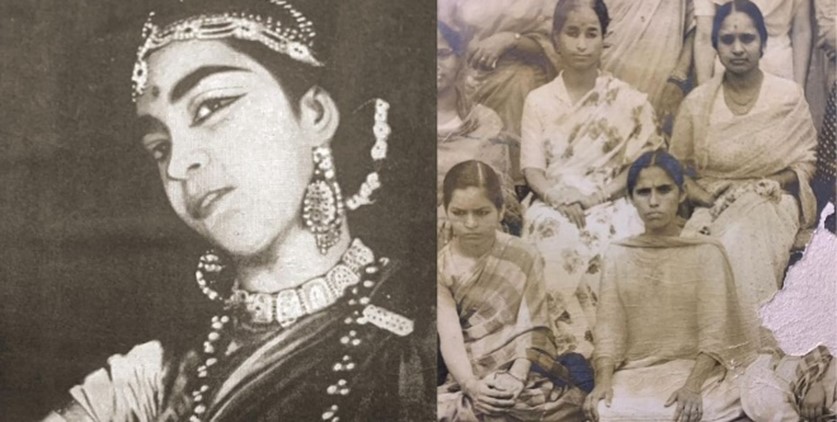
About the Lost Heer Project
- While researching the historic event and interviewing witnesses, Harleen Singh, a social historian and the man behind The Lost Heer Project, realised that the stories of women were particularly compelling, but lacked representation.
- He saw that there was little mention of female characters even in Punjabi history and therefore, he decided to shift the narrative.
- Because women's history in Punjab has not been written down, he considers the wisdom passed down from generation to generation to be the only thing on which he can rely. As a result, he is attempting to document this feminist genealogy.
- Singh's collection encompasses civilizations, iconic figures from that era, art, daily life, holidays, family anecdotes, and snippets from yellowing archives.
- Along with the photographs and paintings Singh was able to obtain from archives and museums, there is also documentary evidence of crucial events in the women's lives that have now frayed with time but remain significant.
Quote: “Social media is not a media. The key is to listen, engage, and build relationships.”-David Alston
Source:
Share the article
Get Latest Updates on Offers, Event dates, and free Mentorship sessions.

Get in touch with our Expert Academic Counsellors 👋
FAQs
UPSC Daily Current Affairs focuses on learning current events on a daily basis. An aspirant needs to study regular and updated information about current events, news, and relevant topics that are important for UPSC aspirants. It covers national and international affairs, government policies, socio-economic issues, science and technology advancements, and more.
UPSC Daily Current Affairs provides aspirants with a concise and comprehensive overview of the latest happenings and developments across various fields. It helps aspirants stay updated with current affairs and provides them with valuable insights and analysis, which are essential for answering questions in the UPSC examinations. It enhances their knowledge, analytical skills, and ability to connect current affairs with the UPSC syllabus.
UPSC Daily Current Affairs covers a wide range of topics, including politics, economics, science and technology, environment, social issues, governance, international relations, and more. It offers news summaries, in-depth analyses, editorials, opinion pieces, and relevant study materials. It also provides practice questions and quizzes to help aspirants test their understanding of current affairs.
Edukemy's UPSC Daily Current Affairs can be accessed through:
- UPSC Daily Current Affairs can be accessed through Current Affairs tab at the top of the Main Page of Edukemy.
- Edukemy Mobile app: The Daily Current Affairs can also be access through Edukemy Mobile App.
- Social media: Follow Edukemy’s official social media accounts or pages that provide UPSC Daily Current Affairs updates, including Facebook, Twitter, or Telegram channels.



